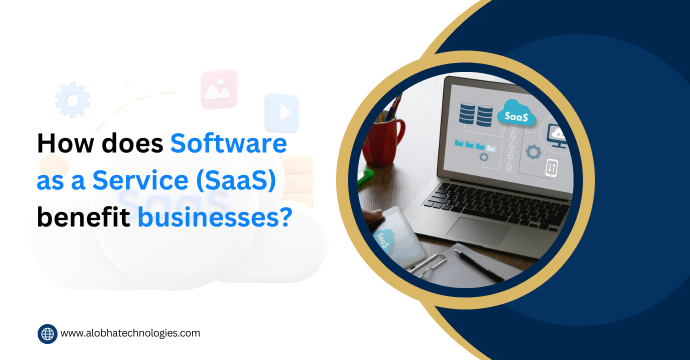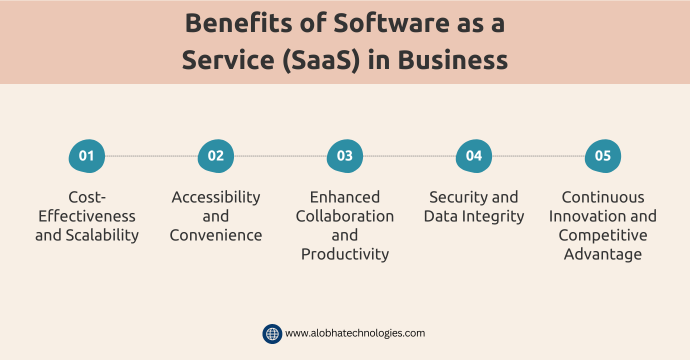
In today’s fast-paced digital landscape, businesses are constantly seeking innovative solutions to streamline operations, enhance efficiency, and reduce costs. One such transformative technology that has gained immense popularity is Software as a Service (SaaS).
SaaS offers businesses access to powerful software applications hosted and maintained by a third-party provider via the cloud. This model has revolutionized the way organizations manage their software needs, providing numerous benefits that contribute to overall growth and success.
What sets SaaS apart from Infrastructure as a Service (IaaS) and Platform as a Service (PaaS)?
Software as a Service (SaaS), Infrastructure as a Service (IaaS), and Platform as a Service (PaaS) are three different models of cloud computing services, each offering distinct levels of control and management to users:
SaaS (Software as a Service):
- SaaS provides ready-to-use software applications that are hosted and managed by a third-party cloud service provider.
- Users access these applications via the internet without needing to install or maintain software locally.
- Examples include web-based email, office software (like Google Workspace or Microsoft 365), and CRM software (like Salesforce).
IaaS (Infrastructure as a Service):
- IaaS offers virtualized computing resources accessible via the internet.
- Users rent virtual machines, storage, and networking resources from a cloud provider on a pay-as-you-go basis.
- Users have control over operating systems, applications, and storage, but they are responsible for managing these resources.
- Examples include Amazon Web Services (AWS) EC2, Microsoft Azure Virtual Machines, and Google Cloud Platform Compute Engine.
PaaS (Platform as a Service):
- It offers a platform that enables customers to develop, deploy, and manage applications without the need to handle the intricacies of building and maintaining the underlying infrastructure.
- It typically includes development tools, database management systems, middleware, and runtime environments.
- Users can focus on coding, testing, and deploying applications without worrying about infrastructure management.
- Examples include AWS Elastic Beanstalk, Google App Engine, and Microsoft Azure App Service.
Key Differences:
- Control and Management:
- SaaS: Users have the least control, as they use the application but do not manage or control the underlying infrastructure or software.
- IaaS: Users have more control over the infrastructure (virtual machines, storage, etc.) but are responsible for managing these resources.
- PaaS: Users have control over applications and data, while the PaaS provider manages the platform itself, including runtime, middleware, and development tools.
- Use Case Focus:
- SaaS: Focuses on delivering software applications directly to end-users.
- IaaS: Focuses on providing virtualized computing resources to build and manage IT infrastructure.
- PaaS: Focuses on providing developers a platform to build, deploy, and manage applications.
Read More: Empower Future with an Innovative Mobile App Development
Benefits of Software as a Service (SaaS) in Business
Businesses that adopt a SaaS solution with a CSP vendor will promptly experience the benefits of transitioning to a SaaS platform. In addition to immediate cost savings, there are other advantages to using a SaaS solution.

Cost-Effectiveness and Scalability
One of the primary advantages of adopting SaaS is its cost-effectiveness. Traditional software often requires substantial upfront investment in licenses, hardware, and maintenance. In contrast, SaaS operates on a subscription-based model, where businesses pay a predictable monthly or annual fee. This eliminates the need for significant upfront capital expenditure, making it particularly attractive for startups and small to medium-sized enterprises (SMEs) with limited budgets.
Accessibility and Convenience
Another compelling benefit of SaaS is its accessibility and convenience. Since SaaS applications are cloud-based, users can access them anytime, anywhere, provided they have an internet connection. This flexibility is especially beneficial in today’s increasingly remote and distributed work environments, where employees may be working from different locations or on various devices.
Enhanced Collaboration and Productivity
Collaboration lies at the heart of modern business operations, and SaaS applications are designed to facilitate seamless teamwork. Many SaaS solutions incorporate collaborative tools such as real-time document editing, project management dashboards, and communication channels. These features enable teams to work together more efficiently, regardless of their physical location.
Security and Data Integrity
Data security is a critical concern for businesses of all sizes, and SaaS providers prioritize robust security measures to protect sensitive information. These measures often include encryption, regular data backups, multi-factor authentication, and compliance with industry regulations (such as GDPR or HIPAA).
Continuous Innovation and Competitive Advantage
In the dynamic digital landscape, innovation is key to maintaining a competitive edge. SaaS providers are committed to continuous innovation, regularly introducing new features and functionalities to enhance their offerings. Businesses can leverage these innovations to stay ahead of market trends, respond to customer demands more effectively, and differentiate themselves from competitors.
Furthermore, SaaS platforms often integrate with other business-critical applications through APIs and third-party integrations. This interoperability enables businesses to create a cohesive ecosystem of tools tailored to their specific needs, enhancing operational efficiency and driving business growth.
Conclusion
In conclusion, Software as a Service (SaaS) has emerged as a game-changer for businesses seeking agility, cost-efficiency, and innovation in their software solutions. By embracing SaaS, organizations can unlock numerous benefits, including cost-effectiveness, scalability, enhanced accessibility, improved collaboration, robust security measures, and continuous innovation.
As businesses continue to embrace digital transformation, SaaS remains a pivotal tool for driving efficiency, productivity, and overall business success in the digital age.
Good one